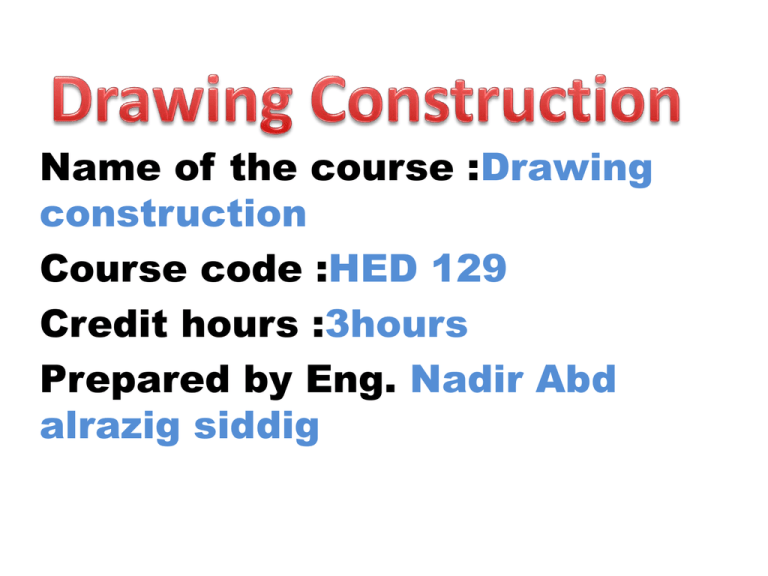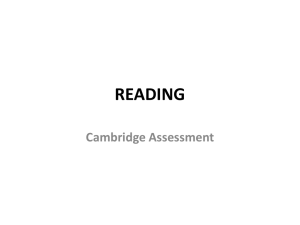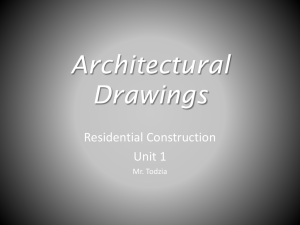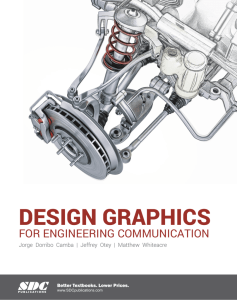Drawing Construction
advertisement

Name of the course :Drawing construction Course code :HED 129 Credit hours :3hours Prepared by Eng. Nadir Abd alrazig siddig Multiview Drawings Multiview drawings can be visualized by what is commonly called the glass box theory. In this process, a three-dimensional object is imagined to be surrounded by a clear glass box (Figure 3-1). If the viewer looks along the perpendicular through any plane on the glass box, the object can be imagined to be a flat, two-dimensional image on that particular glass pane. The object can be viewed from above (called a plan view) or the side (called an elevation view). In turn, if these images are drawn separately, the viewer reverses the process and projects (by imagining) the multiviews onto a whole threedimensional object. Orthographic Projections The word orthographic refers to the projection system that is used to derive multiview drawings based on the glass box model. Drawings that appear on a surface are the view a person sees on the transparent viewing plane that is positioned perpendicular to the viewer’s line of sight and the object. In the orthographic system, the object is placed in a series of positions (plan or elevation) relative to the viewing plane. Single-view Drawings Single-view drawings attempt to picture an object or space as we normally see it in reality with all three dimensions appearing simultaneously. They present relationships of objects, space, and materials in a realistic or photographic-looking manner. Singleview • drawings can be either paraline or perspective views. In paraline drawings, lines are drawn parallel to one another, and object features retain this relationship as they appear to recede in the distance (Figure 3-2). Paraline Drawings • Paralines are usually faster and easier to develop than perspectives, as receding horizontal lines can be drawn with instruments, without calculating depths or drawing lines to a common vanishing point as is necessary in perspective drawings. However, when using computer-aided design (CAD), the speed of the rendering programs will govern which of these is produced the quickest. Paraline drawings are categorized according to the projection method used to develop them, and can be subdivided into two distinct types, axonometric and oblique (Figure 3-3). Axonometric Projections • Some interior designers refer to all paralines as axonometrics; however, axonometric drawings are technically just one form of paraline drawing. Axonometric means “measurable along the axes.” Axonometric drawings include three axes that relate to width, depth, and height. Each line drawn parallel to these axes is drawn at an exact scale with the true length of the object depicted. The axonometric projection system consists of three primary views: isometric, dimetric, and trimetric. These views are distinguished by the degree of variation visible of the principal faces of the object. In the isometric view, all faces represent true scales. Oblique Projections • Oblique projections are popular among interior designers. Although there are several types of oblique drawings, the plan oblique and elevation oblique are the most commonly used. In these drawings, the floor plan or elevation serves as the true face on the picture plane, and parallel lines are projected vertically or horizontally at an angle other than 90 degrees from this face. The viewer’s lines of sight are parallel, but are not at right angles with the viewing plane (Figure 3-4). Perspective Drawings A perspective drawings is a type of singleview drawing that is more realistic-looking than an oblique or axonometric drawing. In a perspective drawing, objects appear to diminish in size as they recede into the distance, and lines that are parallel in the actual object appear to converge at some distant point on the horizon (termed the vanishing point). Perspectives are used primarily as presentation drawings to portray a finished object, building, or interior space (Figure 3-5). Perspectives most closely duplicate what our eye or a camera sees. One-Point Perspectives Of the three types of perspective, the onepoint is perhaps the easiest to understand and construct. In one-point perspectives, receding lines or sides of an object appear to vanish to a single point on the horizon Two-Point Perspective • The two-point perspective is one of the most widely used of the three types, as it portrays the most realistic view for the observer • (Figure 3-7). Three-Point Perspective Three-point perspectives are generally drawn with the viewer at a distance above the horizon (bird’s-eye view) or below the horizon (worm’s-eye view). The three-point perspective is used mostly for very tall buildings and is rarely used in interior spaces, unless they are multistoried. Three-point perspectives are more complicated than the former two types, as a third vanishing point is introduced, which precludes all parallel lines. CW No 2 Draw the chair in isometric by suitable dimension





